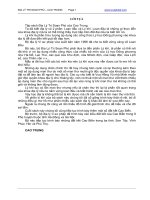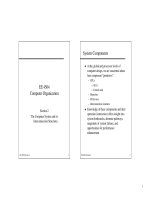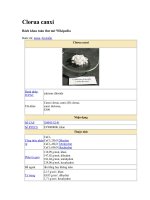Tài liệu Chemical Kinetics pdf
Bạn đang xem bản rút gọn của tài liệu. Xem và tải ngay bản đầy đủ của tài liệu tại đây (1.49 MB, 50 trang )
Chemical Kinetics
The area of chemistry that
concerns reaction rates.
Reaction Rate
Change in concentration (conc) of a reactant
or product per unit time.
Rate =
conc of A at time conc of A at time
2 1
2 1
t t
t t
−
−
=
∆
∆
A
t
12_291
0.0003
70s
O
2
0.0025
0.005
0.0075
0.0100
0.0006
70s
0.0026
110 s
NO
2
NO
50 100 150 200 250 300 350 400
Concentrations (mol/L)
Time (s)
∆
[NO
2
]
∆
t
12_1575
Time Time
(a) (b) (c)
Rate Laws
Rate = k[NO
2
]
n
k = rate constant
n = rate order
Types of Rate Laws
Differential Rate Law: expresses how rate
depends on concentration.
Integrated Rate Law: expresses how
concentration depends on time.
C
4
H
9
Cl + H
2
O → C
4
H
9
OH + HCl
Method of Initial Rates
Initial Rate: the “instantaneous rate” just
after the reaction begins.
The initial rate is determined in several
experiments using different initial
concentrations.
NH
4
+
(aq) + NO
2
-
(aq) → N
2
(g) 2H
2
O(l)
Overall Reaction Order
Sum of the order of each component in the
rate law.
rate = k[H
2
SeO
3
][H
+
]
2
[I
−
]
3
The overall reaction order is 1 + 2 + 3 = 6.
2ClO
2
+ 2OH
-
→ ClO
3
-
+ ClO
2
-
+ H
2
O
Experiment [ClO
2
] M [OH
-
] M Rate, M s
-1
1 0.060 0.030 0.0248
2 0.020 0.030 0.00276
3 0.020 0.090 0.00828
1. Determine the rate law for the reaction.
2. Calculate the rate constant.
3. What is the overall reaction order?
ICA
First-Order Rate Law
Integrated first-order rate law is
ln[A] = −kt + ln[A]
o
Rate =
A
A
−
=
∆
∆
t
k
For
For
a
a
A
A
→
→
Products in a 1st-order reaction,
Products in a 1st-order reaction,
CH
3
NC → CH
3
CN
Conversion of methyl isonitrile to acetonitrile
Half-Life of a First-Order
Reaction
t
1/2
= half-life of the reaction
k = rate constant
For a first-order reaction, the half-life does
not depend on concentration.
t
k
1/2
=
0 693.
Half-Life of a First Order Rx
12_294
[
N
2
O
5
]
0
0.1000
0.0100
0.0200
0.0300
0.0400
0.0500
0.0600
0.0700
0.0800
0.0900
[
N
2
O
5
]
0
2
[
N
2
O
5
]
0
4
[
N
2
O
5
]
0
8
50 150 250 350100 200 300 400
t
1/2
t
1/2
t
1/2
Time (s)
[
N
2
O
5
]
(mol/L)
O
(g)
+ NO
2
(g)
→ NO
(g)
+ O
2
(g)
Pseudo-First Order Rate Laws
y = -100.15x + 22.345
19.00
20.00
21.00
22.00
23.00
0 0.01 0.02 0.03 0.04
time (s)
ln [O]
Types of Radioactive Decay
alpha production (α): helium nucleus
beta production (β):
92
238
2
4
90
234
U He Th→ +
90
234
91
234
1
0
Th Pa e→ +
−
2
4
He
−1
0
e
Types of Radioactive Decay
gamma ray production (γ):
High energy photon
92
238
2
4
90
234
0
0
2U He Th→ + + γ
Decay Series
A radioactive nucleus reaches a
stable state by a series of steps.
90
232
82
208
Th Pb
series of decays
→
21_475
Number of neutrons (A–Z)
Unstable region
(too many neutrons;
spontaneous beta
production)
202
80
Hg (1.53:1 ratio)
110
48
Cd
(1.29:1 ratio)
1
:
1
n
e
u
t
r
o
n
-
t
o
-
p
r
o
t
o
n
r
a
t
i
o
S
t
a
b
l
e
n
u
c
l
i
d
e
s
i
n
t
h
e
z
o
n
e
o
f
s
t
a
b
i
l
i
t
y
6
3
Li (1:1 ratio)
Unstable region
(too many protons;
spontaneous positron
production)
Number of protons (Z)
20 40 60 80 100
20
40
60
80
100
120
0
0
rate = kN
The rate of decay is proportional to the
number of nuclides. This represents a first-
order process.
Decay of Strontium-90
21_477
1 half-
life
2 half-
lives
3 half-
lives
4 half-
lives
10.0
8.0
6.0
4.0
2.0
0
20 40 60 80 100 120
t
1/2
= 2 8.8 t
1/2
= 2 8.8 t
1/2
= 2 8.8 t
1/2
= 2 8.8
Time (yr)
90
38
Mass of Sr (g)
Radioactive Decay
Second-Order Rate Law
For aA → products in a second-order reaction,
Integrated rate law is
Rate =
A
A
−
=
∆
∆
t
k
2
1
A
+
1
A
o
=
kt









